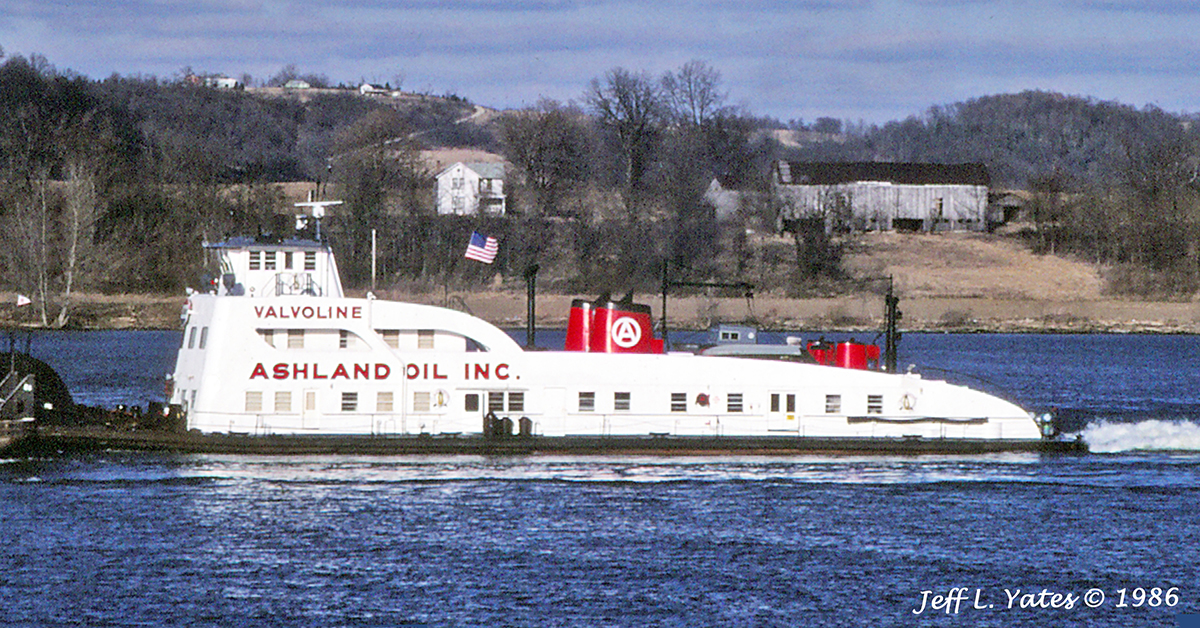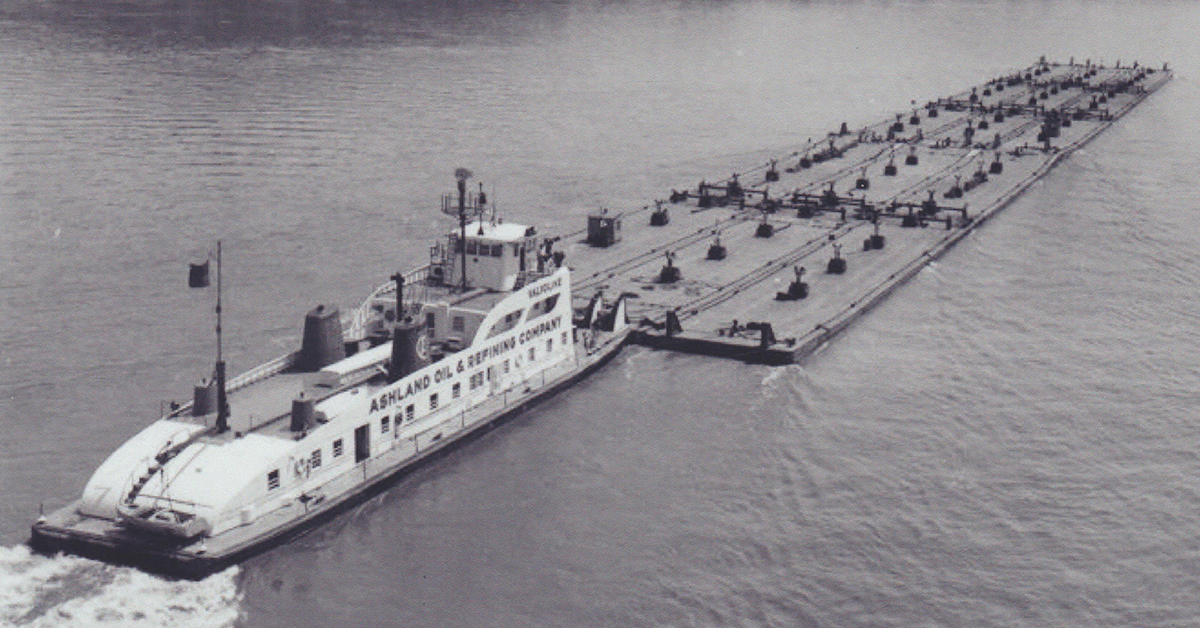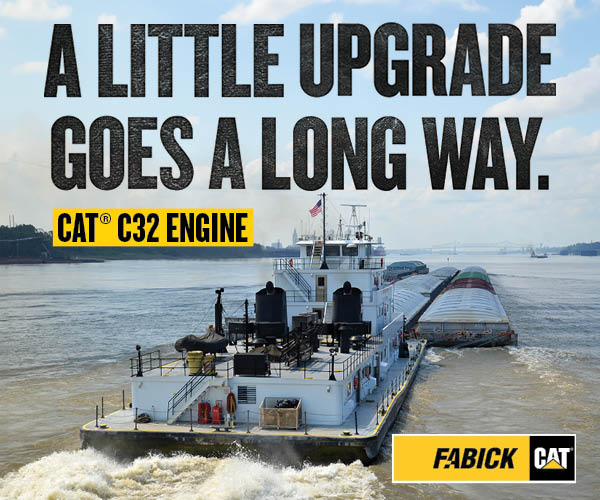Last week this column began looking at the Sohio Cleveland, built in 1949 by St. Louis Ship for the Sohio Petroleum Corporation of St. Louis. The boat, which measured 150 by 35 feet, was twin screw, powered by a pair of GM 16-278A diesel engines, each rated at 1,600 hp. The Sohio Cleveland was christened in St. Louis on April 21, 1949, and had made a very fast initial trip with a three-piece unit of tank barges, also built by St. Louis Ship. The tow was loaded at Mayersville, Miss., on the Lower and then delivered its cargo to Mt. Vernon, Ind., on the Ohio River. The tow averaged better than 8 miles per hour shoving up against the current. The wicket dams were down on the Ohio, creating “open river” conditions so that no locking was necessary.
The Cincinnati news column of the May 28, 1949, issue of The Waterways Journal said the new Sohio boat had been open to the public when it visited the area. The boat also made a short run with guests up to the Cincinnati public landing and back to the company terminal at Bromley, Ky. Aboard with his father for the festivities was 13-year-old William F. “Bill” Judd, who later became a well-known river surveyor and historian.
The Sohio Cleveland and its fast unit tow attracted much attention throughout the remainder of 1949 and into 1950. The fame was short-lived, though. By early 1950, Sohio joined a consortium that owned the Mid-Valley Pipeline. The pipeline would be used to carry crude oil from Louisiana to the consortium’s refineries, thus eliminating the need for much of its river fleet. The selling began when the triple-screw 2,415 hp. Sohioan was sold to The Ohio River Company in May 1950. (See the June 30, 2025, issue of The Waterways Journal.)
The Ashland Oil & Refining Company (AO&R) was formed in 1924 when Paul G. Blazer, acting as an agent for the Swiss Oil Company, purchased a small refinery at Catlettsburg, Ky., on the Big Sandy River. Blazer’s attraction to the refinery was due to its river access. He was placed in charge of the new company and, within a few years, had attained such success that AO&R became the sole entity. Blazer designed the company based on low-cost river transportation, referring to the river system as “the poor man’s pipeline.” By 1950, AO&R had merged with or bought out such oil companies as Allied Oil, Aetna Refining, Freedom-Valvoline and Frontier Oil.
The AO&R fleet at this time consisted of seven towboats, including the three Calumet-built sister vessels Ashland, Paul Blazer and Tri-State, all constructed in 1941 and 1942. In 1948, all three were rebuilt at Dravo, Neville Island, Pa., in a program that included the installation of new sterns with kort nozzles to increase thrust. Blazer was a man who valued innovation and favored investment that would improve performance. The Tri-State, for example, was the first inland rivers towboat to have a working radar, installed in 1946 through the efforts of Robert L. Gray, AO&R’s marine superintendent.
With the knowledge that Sohio was joining the Mid-Valley Pipeline, Blazer was interested in acquiring the still-new Sohio Cleveland and its three-piece tow. He sent Gray to look it over. Relating the story to this writer many years later, Gray said he returned and told Blazer that, in his opinion, AO&R should pass on the boat because “it is built too thin, and we would spend a fortune on it.” Gray continued, “He got mad at me because he had already bought it!” With a sly grin, Gray then said, “But it was built thin, and we did spend a fortune on it.”

The Sohio Cleveland was transferred to AO&R in September 1950. Photos taken shortly after this show it with the SOHIO painted over in the vessel name, leaving only CLEVELAND. In October 1950, the name was changed to Valvoline after the famous oil brand dating to 1866, which was included in the 1949 acquisition of the Freedom-Valvoline Oil Company. The three barges were also included in the sale, but the boat’s easy unit tow days ended when it joined the AO&R fleet. A 150- by 50-foot box barge was built to make a four-piece unit out of the three, and these barges were paired with others to make a full tow. Often as not, the Valvoline could be seen with a tow of 15 195- by 35-foot tank barges for AO&R.
Several of the crew members made the transition from Sohio to AO&R, including deckhand J.A. “Andrew” Riley and oiler J.E. “Joe” Thomas, mentioned in the last column as original crew members. Thomas went on to retire as chief engineer of the second Tri-State. Capt. T. Kent Booth, who had been master of the Tri-State on her historic first trip with a radar in 1946, was later master of the Valvoline and remained in that capacity until his retirement some years later. Capt. Eddie Schubert succeeded Booth, and Capt. Johnny Maxey later succeeded Schubert. Capt. Lonnie Ryan served as relief master for some time until he became master of the Allied-Ashland in the early 1970s. Capt. Chester Workman held that position for many years.
In 1966, the company name changed to Ashland Oil Inc. The Valvoline remained virtually unchanged in appearance over the years. Regarding her streamlined design, a person once commented that it “looked like it was making 5 miles an hour sitting still.”
In 1974, the Valvoline was repowered with a pair of Alco 12-251F engines totaling 3,720 hp. I was privileged to work aboard the boat as pilot in 1986-1987 and can attest to the handling, shoving and backing ability of the St. Louis-designed vessel. In May 1987, Ashland added a new 4,200 hp. Valvoline to the fleet. Capt. Johnny Maxey retired, and Capt. Max English, who had started his pilot career on the original Valvoline in 1963, became master of the new boat.
The first Valvoline was sold to Mon River Towing Inc., Belle Vernon, Pa., in July 1988 and renamed Howard S. Guttman. The boat was last listed in the 1997 edition of the Inland River Record and appeared in the “Off The Record” section of the 1998 book with the notation that it was “out of service” after nearly half a century.
Featured image caption: The mv. Valvoline soon after its acquisition by Ashland Oil & Refining Company. (From the author’s collection)




